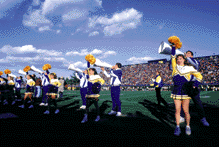

The Blue Hen
By MARGO McDONOUGH
The steel-gray blue hen holds a place in history.
Yes, Virginia, there really is a blue hen. And it's not that 6-foot creature named YoUDee who cavorts with fans at University of Delaware football games.
The actual blue hen would cower at the sight of 22,000 people packed inside Delaware Stadium. "Blue hens, like most chickens, don't enjoy noise and crowds," says Bob Alphin, UD's poultry research coordinator. "They would get stressed out at a football game."
The blue hen is the official mascot of the University of Delaware, as well as the Delaware state bird. However, it's not an officially recognized breed of chicken, says Alphin. The term was first used for a variety of fighting gamecocks that gained fame during the Revolutionary War.
Depending on which story you believe -- and there are several -- the 2nd Company of the 1st Delaware Regiment was led by Capt. John Caldwell, an avid fan of gamecocks. The soldiers of the 2nd Company were said to have amused themselves by staging cock fights with a breed called the Kent County blue hen, which sported blue plumage. Caldwell's men, who were renowned for their fighting prowess, came to be known as "Sons of the Blue Hens."
Over the years, fighting blue cocks became ingrained in Delaware folklore. During the Civil War, another company of Delaware militia was dubbed "Blue Hen's Chickens."
When the blue hen chicken was named the Delaware bird in 1939, small flocks of blue-colored chickens were being raised in the state, but they had little, if any, genetic connection to the Revolutionary-era gamecocks. Bird aficionados kept the flocks for enjoyment; the blue hen was never raised for commercial purposes.
"The blue hen isn't a meaty bird," says Alphin. "It weighs about 4 pounds at 6 months of age while commercial broilers are almost 4 pounds at 5 weeks. And the blue hen isn't a productive egg layer, either."
For a long time, the only Fightin' Blue Hens at UD were the ones on the athletic fields. But S. Hallock du Pont, who raised livestock and chickens as a hobby, created a strain of bird reminiscent -- if not genetically similar -- to the blue hen of Colonial days. In the 1960s, he gave the university a flock of these birds for research and teaching purposes.
The descendants of du Pont's blue hens now live in airy quarters on UD's Newark Farm. The blue hens aren't keen on visitors; even when just a few people enter their coop, they rush to the other side and huddle anxiously together.
But poultry manager Karen Gouge, who is responsible for their care, has seen another side of the blue hens. She says the hens occasionally peck her when she collects their eggs, but it's the males she has to watch out for. "It doesn't happen often, but the roosters have come after me with their spurs," says Gouge. Spurs, which are pointy appendages on the back of the rooster's feet, can grow up to 3 inches long.
"Our blue hens have English gamecock in their heritage, and that's what makes them feisty," says Alphin.
As for the $64,000 question -- are the blue hens really blue? If you're talking like the color of the sky -- no. But you can see an iridescent hue of blue in their steel-gray plumage.
Alphin spends the bulk of his workdays managing a poultry research facility and teaching students, but sometimes, as overseer of the blue hens, he gets called upon for more unusual assignments. Like helping Gouge make sure the flock is bathed and groomed for an impromptu TV appearance. Or primped for a photo shoot for World Book Encyclopedia. He also fields requests from bird hobbyists who will be traveling through the area and hope to meet the blue hens.
But the poultry specialist doesn't mind being something of a press agent and personal manager for a famous flock of hens. "My 8-year-old son, David, thinks I have a very cool job," says Alphin. "After all, he can brag that I help take care of the real Fightin' Blue Hens."
Native Delaware is a weekly column by the university's Cooperative Extension on First State plants, animals and weather.
